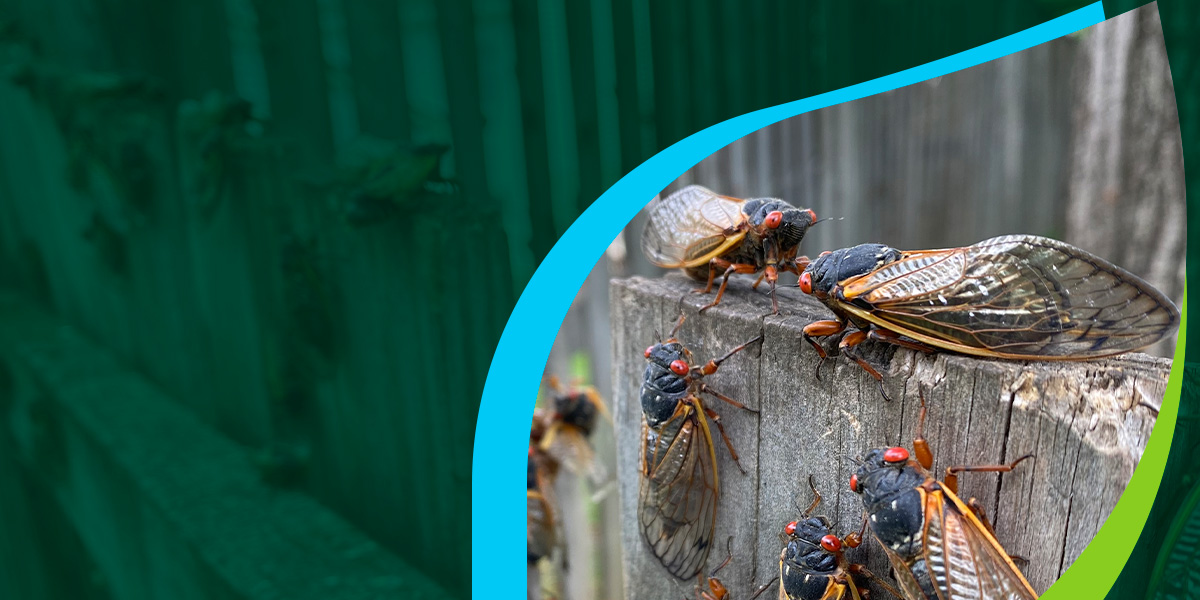
It has been some time since the spring of 2011. If you lived in Maryland at the time, you might recall a deafening noise resounding from the trees and the crunching of shells underfoot. Thirteen years have elapsed since then, and the cicadas have begun to emerge once more.
In 2024, two broods of periodical cicadas are emerging in the Midwest and Eastern United States at the same time — 17-year Northern Illinois Brood XIII and 13-year Great Southern Brood XIX cicadas. This particular double brood only happens once every 221 years!
Although these cicadas will emerge at the same time, they will only overlap in part of Southern Illinois. In Southern Maryland, residents will encounter 13-year Great Southern Brood XIX cicadas.
Here’s what you need to know about periodical cicadas and how to care for your yard and landscaping during their emergence.
Insects probably aren’t your favorite part of the animal kingdom. The list of bugs most people are fond of is relatively short: butterflies, ladybugs, and maybe dragonflies. But to get ready for the return of the 13-year cicada in Maryland, you’ll need to know a bit about its life cycle.
Also known as periodical cicadas, these 13-year and 17-year insects are about 2 inches in length. They have jet black bodies, scarlet eyes, and orange venation throughout their wings. You may see their green-bodied cousins, the annual cicadas, every summer.
Periodical cicadas like Brood XIX live the overwhelming majority of their lives underground, feeding off of plant roots. After 13 or 17 years of such a lifestyle, they emerge as adults to breed in the treetops. Their clock is ticking, as they have less than a month to mate successfully.
Females lay their eggs inside tree twigs, where they will hatch about six weeks later. The cicada nymphs will dig into the ground and wait another 13 years before emerging again to mate.
Scientists believe that cicadas may keep track of time by detecting changes in the fluid they drink from tree roots. However, they’re uncertain how cicadas know which year to emerge.
Cicadas are cold-blooded, so they need warm weather to move and mate. Like snakes and other cold-blooded creatures, they like direct sunlight because it warms their bodies.
When the ground temperature becomes warm in the spring of the right year, cicada broods start digging their way out from underground. After three to four weeks of mating, the adult cicadas will die — usually around the beginning of July.
Because so many cicadas die at once, the area can smell for a few weeks. However, the decomposing cicadas are excellent fertilizer. Piling them in garden beds and under trees allows their nutrients to give plants a boost.
A brood of cicadas is a group that comes out of the ground around the same time. Often, broods include several different species. The Northern Illinois Brood XIII emerging this year consists of three species — Magicicada septendecim, M. cassini, and M. septendecula.
Brood XIX, which southern Maryland residents may encounter, includes four different species of cicadas — Magicicada neotredecim, M. tredecassini, M. tredecim and M. tredecula.
Usually, cicadas are present for six to eight weeks, as they don’t all crawl out of the ground at exactly the same time. During their mating period, the male cicadas sing loudly to attract the females.
The noise can be deafening, reaching decibel levels that may even cause hearing damage in some areas. Each species has its own mating call so the females can tell them apart.
Countless homeowners across the state wonder if Brood XIX poses a threat to their lawns and other elements of their landscape. They are known to damage woody plants such as shrubs and trees, as the females lay their eggs in twigs.
To do this, females use a special organ called an ovipositor to cut a slit into a slim twig. These slits cause minor damage to mature, healthy trees — often, the tree will self-prune these twigs afterward. However, small trees that aren’t established yet can be harmed.
You can take steps to protect young trees and shrubs before cicadas hatch in your area. Netting your young woody plants is an option, but make sure the nets are well-secured and don’t get tangled up.
Nets should have holes smaller than ¼ inch to keep cicadas out. Leave them on only until the cicadas have died because the nets can encourage diseases to develop. By July, the periodical cicadas in Maryland should be gone.
If you don’t have any saplings on your landscape, consider waiting until this fall to add some. By the time Brood XIX returns once more, they’ll be mature and strong enough to withstand these insects without a problem.
It’s not advisable to use insecticide against cicadas. There are too many of them for this to work, and it could be dangerous if your pets decide to eat a cicada that’s been treated. As frustrating as it might be, it’s best to just wait them out.
The emergence of the 13-year cicada is intimidating to some. But it’s fascinating, too. Once you’ve protected your young trees and shrubs, you can sit back and enjoy this seldom-seen spectacle of nature! Remember, this convergence of Broods XIX and XIII won’t happen again for over 200 years.
Looking for an organic lawn care company in Maryland? At OrganicLawns, we’ve been serving customers since 1996. Our company offers ethical and sustainable lawn care practices alongside quality customer service.
We’ll help you nurture a lush, green lawn with quality products that benefit your family and the environment. Healthy lawns start with healthy soil, and our skilled technicians can help you achieve the lawn of your dreams in Maryland.
Contact OrganicLawns online today for a free estimate, or call us at 410-536-5800!